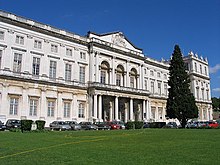Instituto Português do Património Arquitectónico

The Instituto Português do Património Arquitectónico, Instituto Público , often also just IPPAR, IP or even just IPPAR, was the Portuguese national monument protection authority until its tasks were restructured in 2007 . The function of this authority has now been taken over by the Instituto de Gestão do Património Arquitectónico e Arqueológico (IGESPAR). The IPPAR resided in the Palácio Nacional da Ajuda .
History and function
After the Council of Europe adopted the Granada Convention for the Preservation of European Cultural Treasures in 1985 , Portugal ratified the convention with a decree of the President in 1991. As a result, the government under Prime Minister Aníbal Cavaco Silva established a state monument protection agency in 1992 with the name Instituto Português do Património Arquitectónico , in German Portuguese Institute for Architectural Cultural Heritage . The main task of the authority was initially to preserve the Portuguese buildings worthy of monument protection and other Portuguese cultural treasures and to integrate them into the Portuguese cultural landscape. With another decree from 1994, the IPPAR received further rights in the area of the reconstruction of individual buildings. A complete definition of all rights and duties of the IPPAR took place with the passage of Law 120/97 under the government of Prime Minister Guterres . IPPAR was subordinate to the Ministry of Culture from the beginning, but the Minister of Culture was not authorized to issue instructions. Furthermore, it acted financially independently and worked in partnership with the state Instituto Português de Arqueologia , in German Portuguese Archeology Institute .
From 1992 onwards, the IPPAR built up a comprehensive database of monuments that included not only the Portuguese world cultural heritage and the palaces maintained under state supervision, but also numerous private buildings and natural monuments in all parts of the country. For a better division of labor, the IPPAR was divided into seven departments ( Departamentos ), which dealt among other things with financing, administration, research and documentation.
As part of the Programa de Reestruturação da Administração Central do Estado (PRACE), in English "Program for the restructuring of the central administration of the state", the government under Prime Minister Sócrates decided to merge the IPPAR with the Instituto Português de Arqueologia and parts of the General Directorate for National Monuments DGEMN to the newly founded Instituto de Gestão do Património Arquitectónico e Arqueológico, IP . The restructuring took place in 2007/2008, during which time, for example, the websites of both original organizations were still available, as the website of the new institute will only be available from mid-2008.
Individual evidence
- ↑ Decreto do Presidente da República No. 5/91, January 23
- ↑ Decreto-lei No. 106-F / 92, June 1st
- ↑ Decreto-lei No. 316/94, December 24th
- ↑ Decreto-lei No. 120/97, May 16
- ↑ Decreto-lei No. 215/2006, October 27th (PDF, 218 kB)
- ↑ Decreto-lei No. 96/2007, March 29th
Web links
- IGESPAR website with a comprehensive monument database (Portuguese, partly English)
